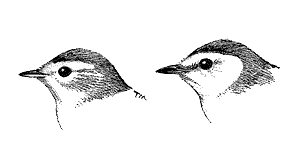
Sketch © Tim Manolis
Warbler
The warbler was originally intended as a photo quiz for the journal Western Birds. This was many years ago when the quiz photos were published in black and white making them much harder to identify. At the time I was enlisted to edit the answer, but there were so many problems that this quiz was never published. However Tim Manolis produced this excellent, previously unpublished sketch showing the difference in head pattern between Hooded and Wilson's warblers.
 |
Female Wilson's Warbler left and Hooded Warbler right showing differences in face pattern. Note the pale lores
and dark auriculars on the Wilson's vs. dark lores and pale auriculars on the Hooded. Sketch © Tim Manolis |
The mystery photo shows the typical face pattern of female Hooded Warbler quite well.
Gull
Most people correctly identified this juvenile Ring-billed Gull. I stated that it was "controversial" but failed to explain the controversy. This bird was seen at the Cordell Bank well offshore. It was on the same July 1994 pelagic trip which also produced the now famous Light-mantled Albatross.
Chris Corben first noticed this unusual gull and called our attention to it. Several experts on board felt quite strongly that the bird was a California Gull because of its large size and hefty build. California Gull is commonly seen in these waters, but Ring-billed Gull is almost unknown offshore away from the immediate coast. Chris and I felt the bird was likely a Ring-billed Gull, but others felt that it could not be because it had the wrong "jizz."
I inflicted the photos on the identification panel at the Western Field Ornithologists convention in Morro Bay several years ago where the panelists, after spirited debate, eventually agreed that it had to be a Ring-billed Gull. Key features include the pale gray greater coverts and inner primaries with distinct black tips. A second year California Gull might show a similar pattern, but would have more brown in the greater coverts and more uniform, less mottled median coverts with less contrast across the wing panel. California Gull should also show a darker shade of gray and an even larger bill.
Common Gull, Larus canus canus, is a good candidate. When Chris and I saw this bird, we thought it might possibly be a "Kamchatka Gull" L. c. kamtschatschensis, which is the largest of the subspecies of Common Gull. But it has never been documented in California. One bird wintering at Palo Alto is now thought to have been a hybrid between Ring-billed Gull and Mew Gull. Although I know little about the juvenile plumage of Kamchatka Gull, I believe that the gray panels should probably be darker on all subspecies of Common or Mew gull.
I have avoided using gulls on these monthly mysteries because there is so much detailed discussion of them in other venues such as Frontiers of Bird Identification. However I hoped that this mystery bird would elicit more informed opinion about juvenile Kamchatka Gull. If anybody knows more, the discussion forum is still open.
The original images are below.
 Photos © Ed Harper and Chris Corben. All rights reserved. |
 |